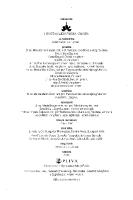Erlang Formulae [PDF]
Erlang B Formula NOTATIONS Pn = Steady-state probability of having n customers in the system λ =Arrival rate (inverse o
38 2 161KB
Papiere empfehlen
![Erlang Formulae [PDF]](https://vdoc.tips/img/200x200/erlang-formulae.jpg)
- Author / Uploaded
- nithinvs
Datei wird geladen, bitte warten...
Zitiervorschau
Erlang B Formula NOTATIONS
Pn = Steady-state probability of having n customers in the system λ =Arrival rate (inverse of average inter arrival time) μ = Service rate (inverse of average service time) N = Average number of customers in the system NQ =Average number of customers waiting in queue T = Average customer time in the system W =Average customer waiting time in queue (does not include service time) X=Average service time X2 = Second moment of service time
ρ= Consider a system which is identical to the M /M /m system except that if an arrival finds all m servers busy, it does not enter the system and is lost instead; the last m in the M/M /m/m notation indicates the limit on the number of customers in the system. This model is in wide use in telephony (and also, more generally, in circuit switched networks). In this context, customers in the system correspond to active telephone conversations and the m servers represent a single transmission line consisting of m circuits. The average service time 1/μ is the average duration of a telephone conversation. The principal quantity of interest here is the blocking probability, that is, the steady-state probability that all circuits are busy, in which case an arriving call is refused service. Note that in an M / M /m/m-based model, the assumption is that blocked calls are lost (not reattempted). This is in contrast with an M / M /m-based model, where the assumption is that blocked calls continuously reattempt admission into service. In data networks, the M/M /m/m system can be used as a model where arrivals
correspond to requests for virtual circuit connections between two nodes and the maximum number of virtual circuits allowed is m. The probability that an arrival will find all m servers busy and will therefore be lost is,
This equation is known as the Erlang B formula and finds wide use in evaluating the blocking probability
Erlang C Formula We usually express the performance measures of M/M/m systems in terms of a probability called delay probability or queuing probability, because this probability is widely used in designing telephony systems. It corresponds to the situation in classical telephony where no trunk is available for an arriving call. Its tabulated results are readily available and hence other parameters can be easily calculated. i.
The probability of delay This is the probability that an arriving customer finds all servers busy and is forced to wait in the queue. This situation occurs when there are more than m customers in the system, hence we have
This probability is often referred to as the Erlang C formula or the Erlang Delay formula and is often written as C(λ/μ, m). Most of the parameters of interest can be expressed in terms of this probability ii.
As the probability mass function Pk consists of two functions, it is easier to first find Nq, the number of customers waiting in the queue, instead of N so that the discontinuity in pmf can be avoided:
iii.
The time spent in the waiting queue:
iv.
The time spends in the queuing system:
v.
The number of customers in the queuing system:
Applications of Erlang Formulae 1. A telephone company establishes a direct connection between two cities expecting Poisson traffic with rate 30 calls/min. The durations of calls are independent and exponentially distributed with mean 3 min. Inter arrival times are independent of call durations. How many circuits should the company provide to ensure that an attempted call is blocked (because all circuits are busy) with probability less than 0.01? It is assumed that blocked calls are lost (i.e., a blocked call is not attempted again). Ans: We have here an M/M/m/m system where m is the number of circuits provided by the company. Therefore we must find the smallest m for which Pm < 0.01 where Pm is given by the Erlang B formula
We have λ= 30 and μ = 1/3, so λ/ μ = 30·3 =90. By substitution in the equation above we can calculate the required value of m 2. A trading company is installing a new 300-line PBX to replace its old existing over-crowded one. The new PBX will have a group of two-way external circuits and the outgoing and incoming calls will be split equally among them. It has been observed from past experience that each internal telephone usually generated (call or receive) 20 minutes of voice traffic during a typical busy day. How many external circuits are required to ensure a blocking probability of 0.02? Solution In order for the new PBX to handle the peak load during a typical busy hour, we assume that the busy hour traffic level constitutes about 14% of a busy day’s traffic. Hence the total traffic presented to the PBX: = 300 × 20 × 14% ÷ 60 = 14erlangs The calculated traffic c load does not account for the fact that trunks are tied up during call setups and uncompleted calls. Let us assume that these amount to an overhead factor of 10%. Then the adjusted traffic = 14 × (1 + 10%) = 15.4erlangs
Using the Erlang B formula:
Again, we solve it by trying various numbers for m and we have m=22 Pm= 0 0254 m=23 Pm= 0 0164 Therefore, a total of 23 lines is needed to have a blocking probability of less than or equal to 0.02.


